Really Strange Beaches
Sandy stretches of gray, brown or even white are the world's norm. Even rocky beaches or those with sheer cliffs barring passage for everyone save the bravest adventurers are not rare. But there are other beaches on Earth that look like they belong on another planet or almost feel like they are on another planet. These unique beaches are some of the best treats nature has to offer.
1. Papakolea Beach, Hawaii, USA
Papakōlea Beach (also known as Green Sand Beach or Mahana Beach) is a green sand beach located near South Point, in the Kaʻū district of the island of Hawaiʻi. One of only two green sand beaches in the World, the other being in Galapagos Islands. It gets its distinctive coloring from the mineral olivine, found in the enclosing cinder cone.
Papakōlea Beach is located in a bay half circled by Puʻu Mahana (a cinder cone) and associated with the southwest rift of Mauna Loa. Since its last eruption, the cinder cone has partially collapsed and been partially eroded by the ocean.
The beach is sometimes named after the cinder cone, and sometimes after the area of land called Papakōlea, which comes from papa kōlea, which means plover flats in the Hawaiian language. Papakōlea is the area near the crater where the Pacific Golden Plover (Pluvialis fulva) are sometimes seen in winter.
It is surrounded by pasturelands and is only accessible on foot or by using a vehicle equipped with four-wheel drive. To actually reach the beach, an additional climb down the cinder cone is required.
2. San Alfonso del Mar Beach, Chile
This beach is located between the largest artificial pool and the largest ocean on the planet Earth. San Alfonso del Mar Beach is an integral part of the luxurious resort of the same name.
Seeing as San Alfonso del Mar fronts a huge beach and the Pacific Ocean, it seems an odd spot for the world's largest swimming pool. But the pool's remarkable spaciousness complements the ocean beyond rather effortlessly, and jumping in the pool's 79°F (26°C) water is a much more tempting prospect than venturing into the 63°F (17°C) seawater nearby, with its dangerous waves and currents.
The resort complex on Chile's central coast resembles a modern Mayan city, with pyramid like apartment buildings towering above the colossal saltwater pool.
Well, since it's over half a mile (1 km) long and holds about 66 million gallons of water, it's more like a lake. Lining the pool are white-sand beaches, palm trees, and docks for the sailboats that ply the gin-clear water.
3. Maho Beach, Sint Maarten
Maho Beach is a beach on the Dutch side of the Caribbean island of Saint Martin, in the country of Sint Maarten. It is famous for the Princess Juliana International Airport adjacent to the beach.
Arriving aircraft must touch down as close as possible to the beginning of Runway 10 due to the short runway length of 2,180 metres (7,150 ft), resulting in aircraft on their final approach flying over the beach at minimal altitude.
Due to the unique proximity of low flying airliners, the location is very popular with plane spotters. This is one of the few places in the world where aircraft can be viewed in their flightpath just outside the end of the runway. Watching airliners pass over the beach is such a popular activity that daily arrivals and departures airline timetables are displayed on a board in most bars and restaurants on the beach, and the Sunset Bar and Grill has a speaker on its outside deck that broadcasts the radio transmissions between pilots and the airport's control tower.
There is a danger of people standing on the beach being blown into the water because of the jet blast from aircraft taking off from runway 10. The local government warns that closely approaching and departing aircraft can "result in serious injury". An additional fence has been added recently behind runway 10, in order to prevent people from hanging on to the main fence surrounding the runway to experience being blasted by the jet flow.
4. Ocean Dome, Japan
This is an artificial beach constructed in the Seagaia resort along the coastal highway outside the city of Myazaki in Japan it has a fully controlled indoor climate throughout the year.
 |
| link |
The Ocean Dome, which was a part of the Sheraton Seagaia Resort, measures 300 meters (1000ft) in length and 100 meters (330ft) in width, sported a fake flame-spitting volcano, artificial sand, artificial palm trees and the world's largest retractable roof, which provided a permanently blue sky even on a rainy day.
 |
| link |
The air temperature was always held at around 30 degrees Celsius (86°F) and the water at around 28°C (82,5°F). The volcano becomes active every 15 minutes and spews fire every hour, and incredible waves lashes the beach for surfers’ delight. The beach can accommodate 10,000 tourists, and the kicker is that there's an actual beach only 300 meters (1000ft) away. It opened in 1993, and visitor numbers peaked in 1995 at 1.25 million a year. The Ocean Dome was officially closed on October 1, 2007 as part of a renovation and partial re-branding of the resort. [link, map]
5. Plage de Saleccia, France
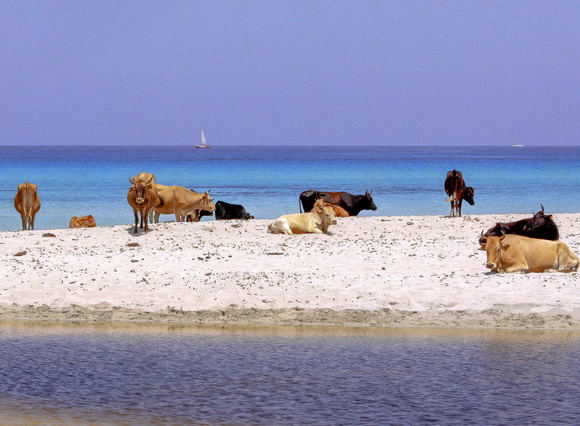 |
| link |
The beach near St-Florent, on the French island of Corsica, is known as Plage de Saleccia and it is a long and undeveloped expanse of dazzling white sand.
 |
| link |
Saleccia, like most of the beaches in the “desert des Agriates”, plays hard to get with its difficult access. The long walk (12 km or 7.5mi) or drive with terrain vehicle, also prevent overcrowding of this fabulous white sand and transparent water place surrounded by sand dunes.
 |
| link |
It is one of the undisputed scenic beaches of the island. Access by boat is also offered from the harbour of St Florent. Saleccia is also place where chestnut-coloured cattle often snooze alongside the sunbathers.
 |
| link |
These cows have a habit of visiting Saleccia beach all year round, so they come here also during the summer season when the beach is full of tourists. [link , map]
6. Pink Sand Beaches, Bermuda
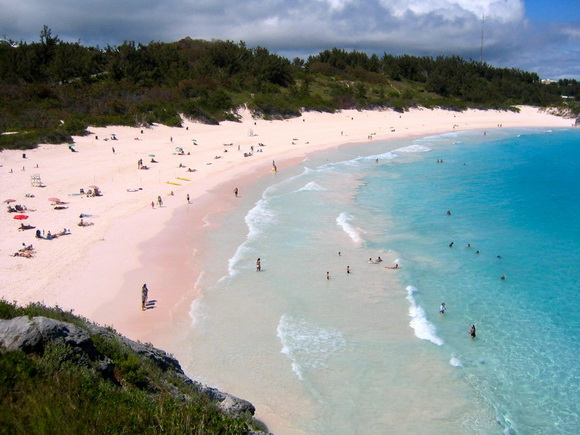 |
| link |
Bermuda has some magnificent large and small beaches. Beach sand is not volcanic but from finely pulverized remains of calcium carbonate shells and skeletons of invertebrates such as corals, clams, forams and other shells.
 |
| link |
Beaches begin with tiny single-celled animals, Foraminifera, in particular, homotrema rubrum - or forams - dark red skeletal animals that grow profusely on the underside of Bermuda's coral reefs. When the red forms die, the skeletons plummet to the ocean floor. Wave action erodes the forams. They become mixed with other debris on the seabed such as the white shells of clams, snails and sea urchins.
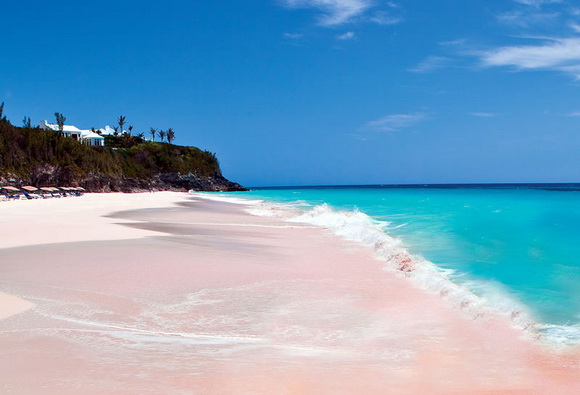 |
| link |
It is at that time that Bermuda's white sand takes on its characteristic pink hue. Bermuda is one of the northernmost areas in the Western Hemisphere (but not the northernmost place in the world) for coral reefs. In Bermuda, see the contrast of pink sand, turquoise water between the shoreline, outlying reefs, and dark blue of the ocean beyond the reefs or land.
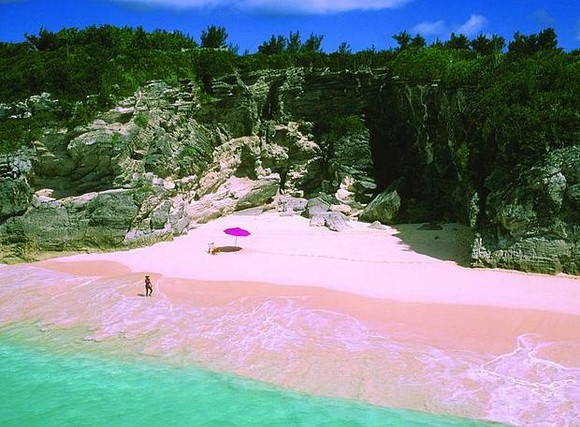 |
| link |
The sand in Bermuda is exceptionally fine. Beaches in Bermuda are often favored for weddings. Most beaches are on the South Shore, but a few are on the North Shore. [link , map]
7. Playa de Gulpiyuri, Spain
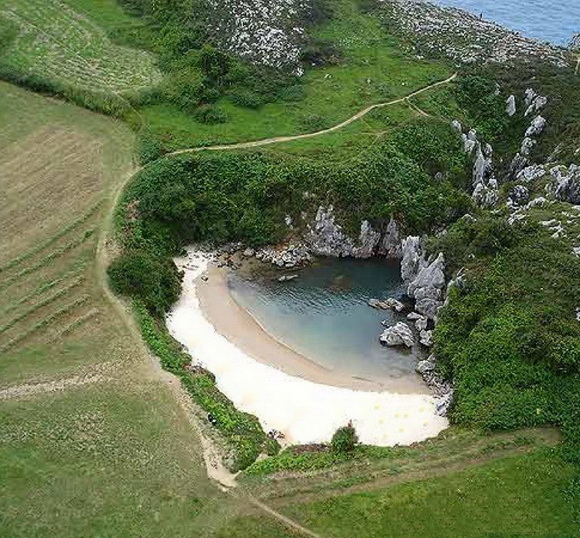 |
| link |
Playa de Gulpiyuri is a flooded sinkhole with an inland beach located near Llanes, Spain around 100 m (330ft) from the Cantabrian Sea.
 |
| link |
Roughly 40 meters (130ft) in length, it is fully tidal due to a series ofunderground tunnels carved by the salt water of the Cantabrian Sea which allows water from the Bay of Biscay to create small waves.
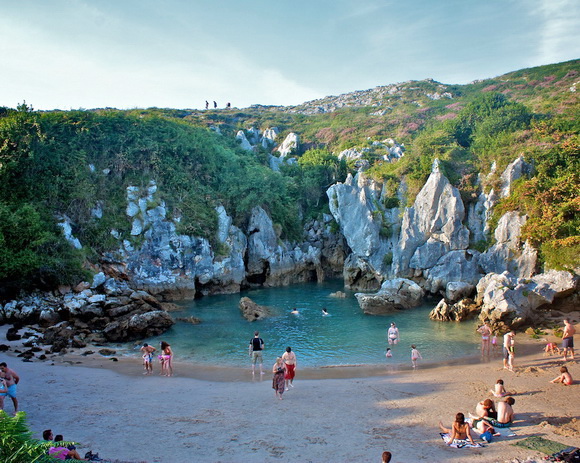 |
| link |
It is a popular tourist destination, natural monument, and part of Spain's Regional Network of Protected Natural Areas. [link, map]
8. Hot Water Beach, New Zealand
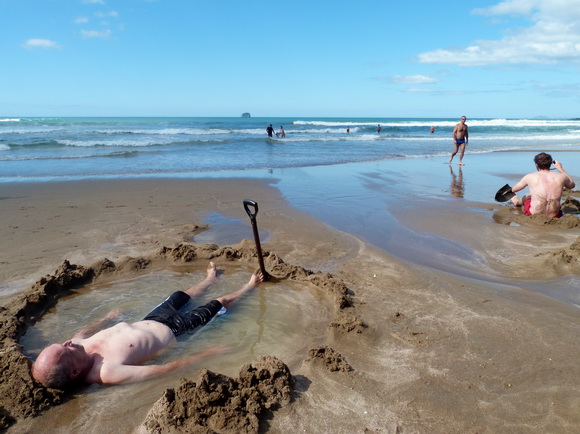 |
| link |
Hot Water Beach is a beach on the east coast of the Coromandel Peninsula, New Zealand, approximately 12 kilometres (7.5mi) south east of Whitianga, and approximately 175 kilometres (110mi) from Auckland by car. Its name comes from underground hot springs which filter up through the sand between the high and low water tidal reaches.
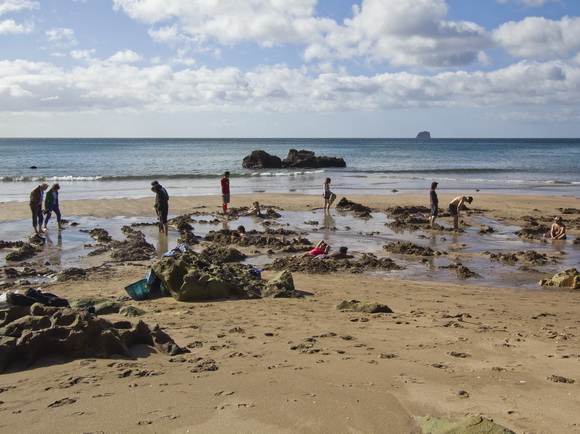 |
| link |
The beach is a popular destination both for locals and tourists visiting New Zealand. Annual visitor numbers have been estimated at 700,000, making it one of the most popular geothermal attractions in the Waikato Region.
 |
| link |
Within two hours either side of low tide, it is possible to dig into the sand allowing hot water to escape to the surface forming a hot water pool. The water, with a temperature as hot as 64°C (147°F), filters up from two underground fissures located close to each other. These natural springs can be found on the beach opposite the off-shore rocks. Visitors often dig large holes and relax and soak in the thermal water. Many visitors bring a spade and bucket with them. Spades can also be hired from the nearby surf shop. [link, map]
9. Hidden Beach on Marieta Islands, Mexico
 |
| link |
Protected from the intrusion of the world outside, the hidden beach of Marieta Islands, Puerto Vallarta is a world of its own. Located just a few miles off the coast of Mexico, close to Bandera bay, Marieta Islands are archipelagos that were formed as a result of volcanic activity. The islands have remained almost secluded ever since. It was only recently that recreational aspect of the place was discovered following development of an extremely exclusive marine ecosystem that makes this place just as unique as thrilling.
 |
| link |
The water along the hidden beach Marieta Island, Puerto Vallarta is a crystal clear blue mass of pure bliss. Of the marine wildlife available to view in the place, Humpback whale, sea turtles and dolphins are just a few of the most magnificent examples. Travelers can also enjoy a powerboat trip to the hidden beach, Marieta Island, Puerto Vallarta taking in the scenery along the way.
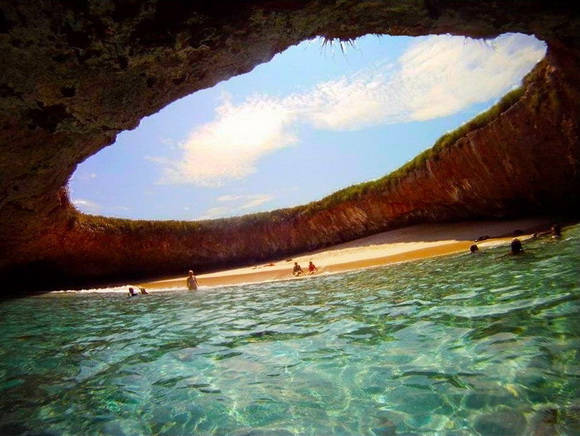 |
| link |
The hidden beach, Marieta Islands, Puerto Vallarta is an intriguing site in its own accord. The beach remains cut off from rest of the group of islands. And for those who stumble across the place, the surprises held are immense. The beach is considered to possess an abundance of reef fish, with about 103 different speciesmoving around in the clear blue waters of the beach. [link, map]
10. Loango’s Wild Forested Beach, Gabon
 |
| link |
This forested beach is located in Loango National Park in western Gabon. Loango’s wild forested beach is one of the few places in the world where great mammal herds still have access to the sea, and one of the last places in the world with Hippopotamus in the surf. Buffalo and Forest Elephant herds graze on the coastal grasslands and wander on the beach.
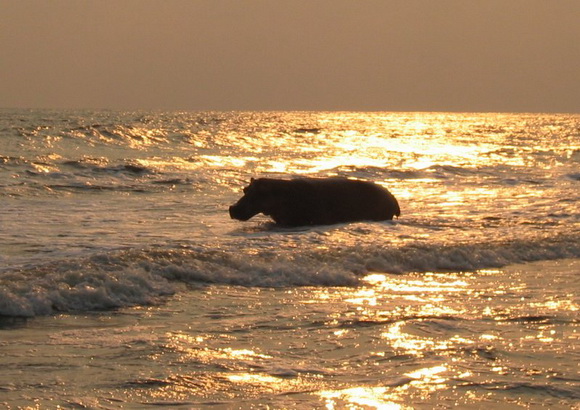 |
| Surfing hippo in Atlantic Ocean link |
Even gorilla families are occasionally seen foraging in beachside trees. Many of these beaches provide significant habitat for migrant shorebirds, including African Skimmers and Damara Terns, both with populations that are dropping quickly elsewhere in Africa.
 |
| African forest buffalo on the beach link |
With hunting bans in the park area, Loango’s animals are rapidly acclimating to people, thus becoming more visible to tourists. Quiet walks with trained ecoguides will provide opportunities for tourists to see gorillas, chimps, monkeys, duikers, and hundreds of forest birds. [link , map ]
11. Airport Beach, UK
 |
| link |
Barra Airport is probably the only airport in the world where planes land on the beach. BRR is situated in on the wide beach of Traigh Mhor, on Barra island, in the Outer Hebrides, Scotland. If you want to fly here commercially you will want to book with British Airways, which flies to Barra from Glasgow and Benbecula.
 |
| link |
The airport is literally washed away by the tide once a day, and if you arrive on a late afternoon flight, you may notice a couple of cars in the parking lot with their lights on, which provides pilots some added visibility, since the airport is naturally lit.
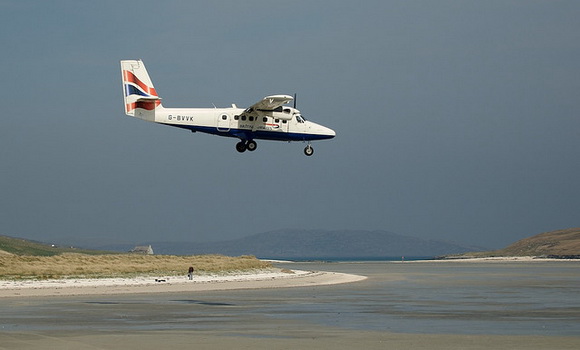 |
| link |
Needless to say you probably don't want to hang out at Barra Airport beach, unless you are a aviation junkie, in which case Barra Airport has a fool proof system, as sign that reads: "Keep off the beach. When the windsock is flying and the airport is active." [link , map ]
12. Chandipur Beach, India
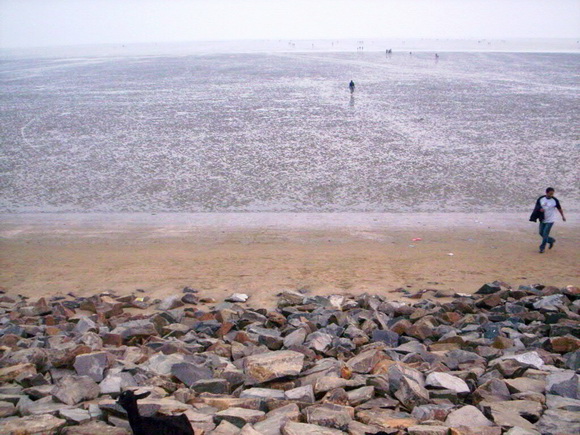 |
| link |
Have you seen the sea disappear in front of your eyes? A unique phenomenon rarely seen anywhere else, the sea recedes by as much as five kilometres (3 mi) every day on the Chandipur beach in eastern India, not just enthralling the onlooker but also offering an opportunity to literally walk into the sea.
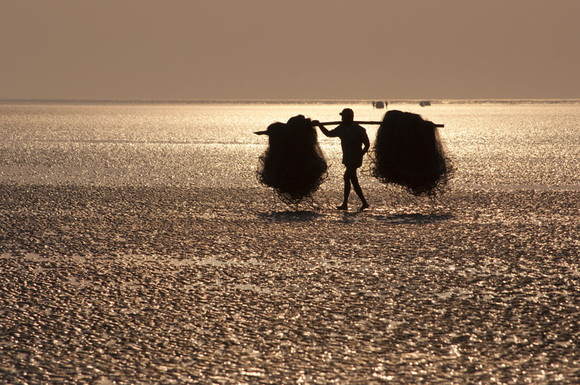 |
| The Fisherman at Chandipur beach link |
At the occurrence of low tide tourists are able to explore the seabed, complete with shells, driftwood and little red crabs. Due to the unique circumstances, the beach supports bio-diversity. Horseshoe crab is also found here on the beach towards Mirzapur, the nearby fishing market and community at the confluence of the Budhabalanga River.
 |
| link |
A lot of modern government and private hotels are available here at affordable cost. Tourists visiting the place never like to go back. [map ]
13. Scala dei Turchi, Italy
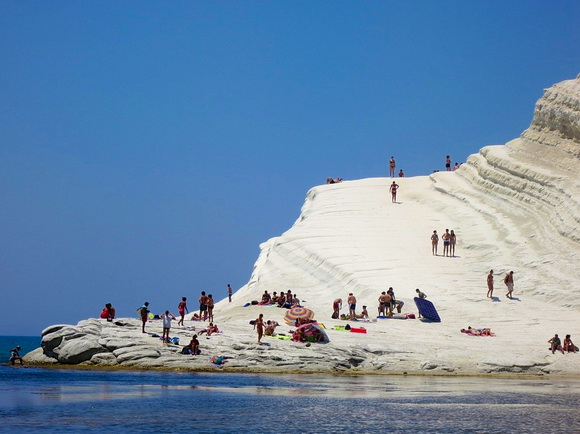 |
| link |
The Scala dei Turchi (Italian: "Stair of the Turks") is a rocky cliff and beach on the coast of Realmonte, near Porto Empedocle, southern Sicily, Italy. It has become a tourist attraction due to its unusual white color.
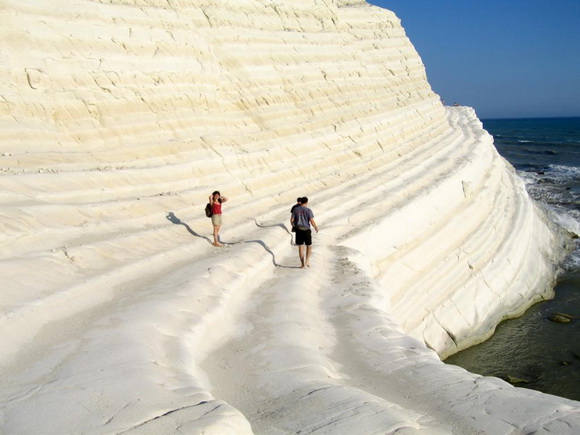 |
| link |
The Scala is formed by marl, a sedimentary rock with a characteristic white color. It lies between two sandy beaches, and is accessed through a limestone rock formation in the shape of a staircase, whence the name. The latter part of the name derives from the frequent raids carried on by Turks.
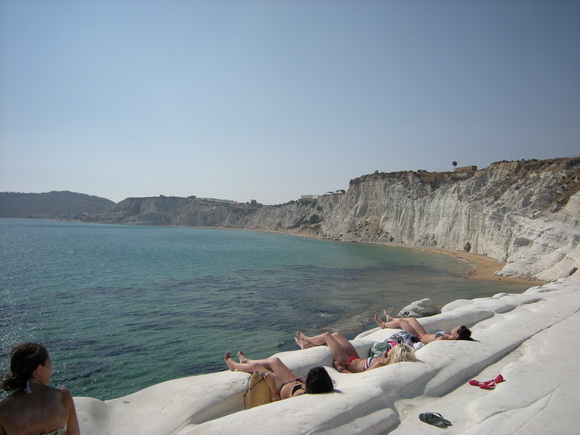 |
| link |
In August 2007, the municipality of Realmonte applied for the inclusion of the Scala dei Turchi (together with the nearby Roman Villa Aurea) in the UNESCO Heritage List. [link , map ]
14. Bowling Ball Beach, USA
 |
| link |
On the Californian coast is a town called Mendocino. Nearby is a coastal feature called Schooner Gulch, and this is where you can feast your eyes on what has become known as the 'Bowling Ball Beach'.
 |
| link |
Thousands of rocks appear to have gathered together to defy the tides like an army of small boulders. The weird thing is that these boulders are uniform in size and shape, as well as in their spacing, though man has nothing to do with it.
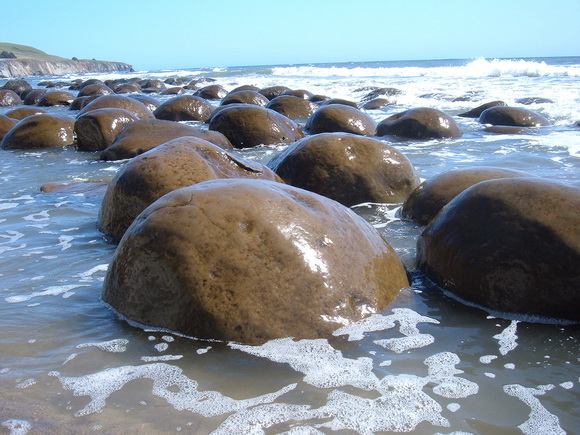 |
| link |
The explanation is simple and purely geological in nature. Over thousands of years, this has eroded away under the constant onslaught of the Pacific Ocean, forming the cliffs that line the shore behind the beach and leaving the tougher 'bowling balls' behind.
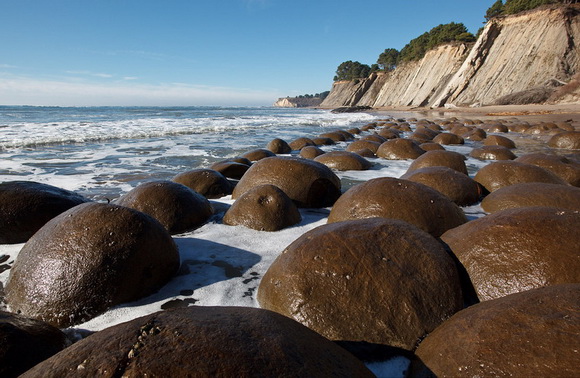 |
| link |
This may not seem like much of a hotspot for visitors, but the uniqueness of it makes the effort well worth it. You may see things more breathtaking than this incredible bowling ball beach, but you'll never see anything quite like this anywhere else. [link , map]
15. Glass Beach, USA
 |
| link |
Glass Beach is a beach in MacKerricher State Park near Fort Bragg, California that is abundant in sea glass created from years of dumping garbage into an area of coastline near the northern part of the town.
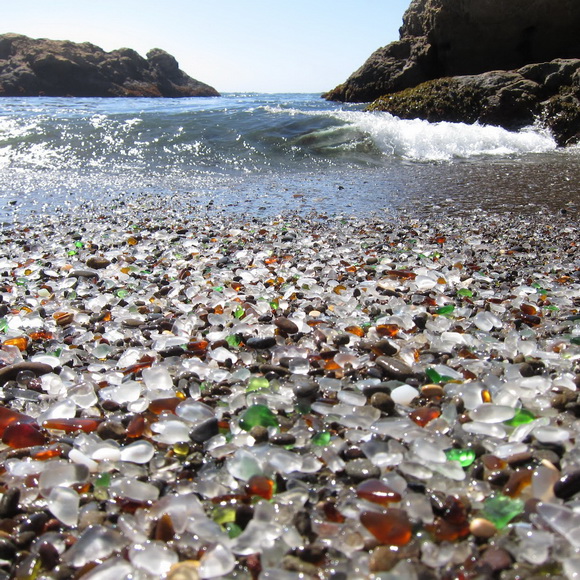 |
| link |
The beach is now frequently visited by tourists. Collecting is not permitted on the park's beach, although sea glass can be found on other local beaches outside the park boundary. A Glass Festival is held annually on Memorial Day weekend.
 |
| link |
Thousands of tourists visit Fort Bragg's glass beaches each day in the summer. Most collect some glass. Because of this and also because of natural factors (wave action is constantly grinding down the glass), the glass is slowly diminishing. There is currently a move to replenish the beaches with discarded glass. [link, map]
|

No comments:
Post a Comment